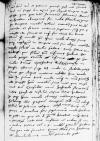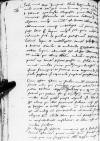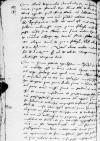Non scripsi Dominationi Vestrae Reverendissimae per aliquod tempus. Causa est haec, quia per totum Ianuarium, Februarium, Martium et Aprilem, obnoxius fui malis fluxibus (quos hoc tempore morbum Gallicum vocant), quos tandem secunda et fortiori unctione superavi sumque per 4 menses ita sanus, uti umquam fui. Utinam diu duret. Mirum, quam multi hic huic malo obnoxii sunt quique negligunt in tempore curam sui, aliqui moriuntur, multi salutem in dubio habent. Dominus ⌊Petrus von Andorff⌋, qui filiam domini Cossmus habuit hoc malo periit, similiter et Cossmus, ... illegible⌈...... illegible⌉ etiam hoc malo, dominus Gotthardus Rossczysyewsky in ⌊Prussia⌋ ⌊Gdani⌋, super eodem malo in stubella periit.
Sunt etiam aliquot matronae nobiles huic malo datae. In summa dicunt multi numquam in nostris partibus adeo saevisse hunc morbum sicut nunc, qua causa moti domini consules novum hospitale struxerunt inter ⌊Cracoviam⌋ et ⌊Vistulam⌋, versus latus ⌊Iudaeorum⌋. In eoque huic malo obnoxii curantur pauperes. Habentque illic proprium cirurgicum. Sed nunc relinquam ⌊Galliam⌋, de ⌊Polonia⌋ reliqua, serenissimus ⌊dominus noster senior⌋ a duabus fere septimanis male habuit ex pede, in quo, uti dominus ⌊Ioannes Benedicti⌋ mihi dixit, a semet ipso nata erat inflatio cum rubore. Sed iam a tribus diebus vel a 4 nullum periculum habent, immo pro voto sanatur, quare ⌊maiestas sua⌋ hactenus non obambulavit multum, parcendo pedi.
 BK, 230, p. 286
BK, 230, p. 286
Serenissimus ⌊rex iuvenis⌋, ⌊maiestas reginalis⌋ et reginulae om<n>es, deo gratia incolumes sunt. Saltem dominus ⌊Petrus Opalinski⌋, magister curiae ⌊maiestatis regiae iunioris⌋, febricula et catarro laborat. In ⌊cuius⌋ absentia mihi iniunctum est docere ⌊illius maiestatem⌋ Allemanice iamque intelligit non pauca et legit satis bene. Sed loqui nihil scit, quia nondum colloquia ordinata sunt, ex quibus potissimum disceret, verum Latine loqui et intelligere, tantum dididicit a domino doctore ⌊Siculo⌋ et audiendo parentes et alio crebro loqui, adiuvante etiam ad hoc idiomate orig. ideomate⌈idiomateidiomate orig. ideomate⌉ Italo uti omnes, qui illius maiestatem audiunt, censent alias puerum vix tantum discere posse in scholis in 5 vel 6 annis, multa sunt, quae de superinscribed⌈dede superinscribed⌉ singularissimo ingenio ⌊istius principis⌋ et sororis eius ⌊reginulae Isabellae⌋ scribi possent, sed requirunt scriptorem perfectiorem me.
Cum essem ⌊Gdani⌋ in Iulio, omnes amicos Dominationis Vestrae Reverendissimae sanos vidi, qui summopere cupiunt reditum Dominationis Vestrae, tota praeterea patria desiderat idipsum omnes superinscribed⌈omnesomnes superinscribed⌉ sperantes Dominationem Vestram Reverendissimam non minus facturam pro patria fa, quam dominum ⌊episcopum Varmiensem⌋, de quo multa dicunt, quantum prosit reipublicae isti. Nec est hoc tempore alius, qui illam provinciam fulciat, nisi ipse dominus de Bayssen, et dominus ⌊Czema⌋, cum civitatibus tamen quamvis etiam non undique cum civitatibus conveniunt, irrepserunt aliquot domini aliunde illuc, qui omnia fortissime trahunt in consuetudines insolitas et contra etc. Non ausim multa scribere.
In Augusto praeterito mortuus est dominus ⌊Balinski⌋ castellanus Gdanensis, quare omnes ⌊domini Pruteni⌋ proprio motu, pro me scripserunt ⌊maiestati regiae⌋, meque moverunt,  BK, 230, p. 287 ut instarem pro officio procuratoris castri Marienburgensis, sed victus sum a domino ⌊Stanislao Costka⌋. Ille obtinuit thesaurariatum et procuratoris officium castellanatus Gdanensis nondum cuique datus est. Rogamus hic pro domino ⌊Achacio Czema⌋, alii rogant pro domino Michaele Czyelyslawsky in ⌊Myedzyląz⌋, miramur omnes, causam more.
BK, 230, p. 287 ut instarem pro officio procuratoris castri Marienburgensis, sed victus sum a domino ⌊Stanislao Costka⌋. Ille obtinuit thesaurariatum et procuratoris officium castellanatus Gdanensis nondum cuique datus est. Rogamus hic pro domino ⌊Achacio Czema⌋, alii rogant pro domino Michaele Czyelyslawsky in ⌊Myedzyląz⌋, miramur omnes, causam more.
Itaque dominus ⌊Ioannes de Bayssen⌋ filius domini ⌊palatini Mari(enburgensis)⌋ ducit ⌊filiam⌋ domini ⌊Ludovici de Mortang(en)⌋, cuius filius ⌊Ludovicus⌋ fuit apud Dominationem Vestram Reverendissimam. ⌊Quem⌋ missurus est (uti mihi dixit) ad ⌊ducem Bavariae⌋ cum falconibus et uno servitore, ut serviat, sed non cum equis, quia adhuc iuvenis est, nesciret forte se disponere cum equis.
Dominus ⌊Nipschicz⌋ optime sanus est estque bonus mihi fautor, triumphat semper, bibit, ludit nec in ulla re mihi mutatus esse videtur, nisi quod ditior sit factus, non tamen victus divitiis in moribus, dominus ⌊Gotz⌋, dominus ⌊Fabianus Czema⌋ etiam bene sani sunt, et saepe precantur felicitatem Dominationi Vestrae Reverendissimae.
Heri mihi redditae sunt litterae domini ⌊Martini Czeyma⌋ canonici Culmensis et administratoris episcopatus Dominationis Vestrae Reverendissimae, quibus mihi scribit de exustione oppidi ⌊Culmenshe⌋, post aliquot horas his inclusas litteras ad Dominationem Vestram Reverendissimam mihi quidam cubicularius ⌊reginulae Hedwigis⌋, ⌊Camyenski⌋, misit, sic, uti Dominatio Vestra Reverendissima videbit, rupta aut violata custodia, dixitque non voluntarie ruptam esse, nec dubito verum esse. Ego habens eas, istis inclusi, non legi, quia scio non decere, dixique de eis domino ⌊Nipschicz⌋.
 BK, 230, p. 289 Cum ⌊maiestas reginalis⌋ obambularet in horto suo novo super feriali, dixi illius maiestati de illa exustione illius oppidi, quod illius maiestas non libenter audivit interrogavitque me tunc, quantum reddat annuatim ille episcopatus. Respondi, uti verum est, me certe nescire saltem audivisse circa 3000 florenos inde habere hidden by binding⌈[re]re hidden by binding⌉ posse, respondit ⌊sua maiestas⌋: “An sine victu?” Dixi: “Forsan ex omnibus collectis vix tantum facit, salte tamen ita aliqui dicunt de 3000 florenis.” Nil aliud tunc de Dominatione Vestra Reverendissima, verum alias crebro mentio bona hidden by binding⌈[a]a hidden by binding⌉ fit de Dominatione Vestra Reverendissima, sed cum de reditu incipimus ”Nondum hidden by binding⌈[m]m hidden by binding⌉ advenisse tempus” - dicit.
BK, 230, p. 289 Cum ⌊maiestas reginalis⌋ obambularet in horto suo novo super feriali, dixi illius maiestati de illa exustione illius oppidi, quod illius maiestas non libenter audivit interrogavitque me tunc, quantum reddat annuatim ille episcopatus. Respondi, uti verum est, me certe nescire saltem audivisse circa 3000 florenos inde habere hidden by binding⌈[re]re hidden by binding⌉ posse, respondit ⌊sua maiestas⌋: “An sine victu?” Dixi: “Forsan ex omnibus collectis vix tantum facit, salte tamen ita aliqui dicunt de 3000 florenis.” Nil aliud tunc de Dominatione Vestra Reverendissima, verum alias crebro mentio bona hidden by binding⌈[a]a hidden by binding⌉ fit de Dominatione Vestra Reverendissima, sed cum de reditu incipimus ”Nondum hidden by binding⌈[m]m hidden by binding⌉ advenisse tempus” - dicit.
Cum in Iunio praeterito appulissem in episcopatum Dominationis Vestrae Reverendissimae, omnia intellexi esse in bono ordine. Equos meos inde tunc recepi habeoque eos apud me, nec adhuc intelligo, si consultum sit, ut eos in ⌊Goląbye⌋ mittam, praesertim hoc tempore, quo pauci aulici sunt in curia. Maior enim pars eorum missi sunt in ⌊Podoliam⌋ contra ⌊Vallachum⌋, de cuius insolentia et protervitate forsan alii omnia perscripserunt, quare pauca tamen repetam. Cum enim iste ⌊palatinus Vallachiae⌋ occupasset districtum Pokwczye verum hidden by binding⌈[erum]erum hidden by binding⌉ ⌊maiestas regia⌋ misit contra ipsum exercitum 3000 hominum, qui aliquoties in Pokwczye triumphavit de ⌊Vallachis⌋, proxima autem vice, cum ⌊Vallachus⌋ in propria persona cum viginti millibus, uti dicunt, et 30 tormentis aggressus fuisset nostros in der ⌊Wagenburgk⌋, ubi nostri strenue omnes profligarunt, multos interemerunt, dicunt 3000 non pau hidden by binding⌈[non pau]non pau hidden by binding⌉cos captivarunt et huc miserunt. Ipse etiam ⌊palatinus⌋ non sine vulnere dicitur aufugisse, nescitur tamen certe.
 BK, 230, p. 287 ut instarem pro officio procuratoris castri Marienburgensis, sed victus sum a domino
BK, 230, p. 287 ut instarem pro officio procuratoris castri Marienburgensis, sed victus sum a domino  BK, 230, p. 289 Cum
BK, 230, p. 289 Cum 


